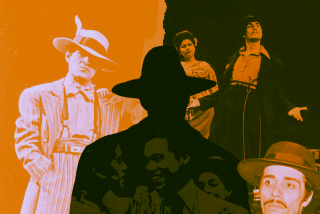Cultural Chameleons : Lifestyle: Details count when German ‘tribes’ masquerade as Vikings or Huns: ‘It’s really tough to get decent camel skins.’
- Share via
COLOGNE, Germany — The neighborhood butcher was understandably perplexed the first time Wolfgang Wettstein placed his special order. Nobody had ever wanted to buy cow teeth before.
“I need them to sew my tepee with,” Wettstein said, explaining how Plains Indians once fashioned pieces of buffalo tooth into needles.
Wettstein’s painstakingly stitched tepee turned out to be more than his second home. It is his second life.
Grown-ups playing Indian is just one small part of an elaborate, expensive masquerade in which thousands of Germans quietly indulge with a serious passion.
There are accountants who drape themselves in animal pelts and gnaw on raw meat as weekend Huns; dentists in armor who march past Benetton shops as Roman legionnaires; businessmen in horns who honor their dead with mock Viking funerals on the Rhine.
All are dues-paying members of Germany’s private “tribes”--cultural chameleons who emulate lost ways of life to a sometimes obsessive degree.
When the wild calls, they answer.
What motivates these hobbyists is a question for historians, sociologists, psychologists and the tribes themselves to ponder. The reasons are as varied as the museum-quality costumes that members typically spend years making by hand.
For some, these fantasy worlds offer escape from a rigid, high-tech society. For others, cultural metamorphosis is the ultimate acting out of a love of history.
“It’s typical German romanticism on one hand, and typical German thoroughness on the other,” says Friedrich Wolfram Heubach, a psychology professor familiar with the “tribe” scene.
“The theory is that Germans are so successful in science and technology because they’re so disciplined and industrious and driven,” Heubach says. “It’s a . . . repressed society,” he adds--and playing “barbarian” is a way to vent aggression.
“The joke is that it starts out as lots of fun, but because they’re Germans, before long there are statutes and rules,” Heubach says. “They begin organizing their escape exactly like the life they were trying to flee.”
That means long lists of nit-picky do’s and don’ts, including punctual powwows for the Indians and democratic Hun elections for Attila. It means that would-be samurai can’t wear their swords in public, and Mongolian hordes have to remember to get camping permits.
“You can’t relive history,” says Klaus Schwab, a dentist who is a recreational Roman legionnaire. “It all falls apart the instant the phone rings or the mailman comes.”
Although some of the modern German tribes date back to the turn of the century, most are thought to have sprung up after World War II, primarily around Cologne. Dressing up and going wild is an annual pre-Lenten rite during Karneval, and Cologne is Germany’s undisputed New Orleans.
“Cologne is a biosphere for wackos,” boasts Heiner Doensdorf, a 40-year-old video producer who has been an ardent Hun since 1968. “If I spent a year in L. A., though, I’m sure I could start a Hun tribe there too. No problem.”
Well, OK, there are some problems.
“It’s really tough to get decent camel skins,” Doensdorf complains, noting that no Hun household is complete without them.
His 18-member Hun tribe--one of scores nationwide--meets 15 times a year to discuss history, work on costumes and plan things like “who’s going to order the beer for our summer fest.”
Beer?
“We’re still Germans,” Doensdorf said.
But tribe members privately admit that some people do cross the reality border.
There are tales of an entire family living as Vikings year-round, and German Indians who start talking like Tonto.
Some of the more serious tribes--many have extensive libraries--scoff at clubs that remain strictly Karneval groups.
“There is an abstract competition among tribes,” Heubach says. “Who is more authentic? Who eats raw meat? Who knows the most about Huns? Which Indians have genuine eagle-feather headdresses?”
Although the tribes vehemently deny it, it is sometimes difficult for outsiders to see the distinction between emulation and racism.
Several groups, for example, call themselves “man-eaters,” “jungle brothers” or “cannibals.” They paint their faces black, wear curly wigs and bedeck themselves with bone jewelry.
While some genuinely study primitive African tribes and say their imitation is out of curiosity and respect, others clearly consider it a good Karneval joke.
During a recent museum exhibit here of portraits of Cologne tribes, an Ethiopian couple paused in front of a photo of “people-eaters.”
“I worry about what this says to a German child,” the man said. “If they see me as a black man walking down the street, will they wonder if I’m going to eat them?”
More common, though, are people such as Charly Wenzel, a 65-year-old retired truck driver who has been an ersatz Lakota Indian for 24 years.
Even when the tribe is not meeting, Wenzel affects a decidedly un-Teutonic image, tying his long gray ponytail back with a leather thong and sporting turquoise jewelry.
“We’re Europeans, and we can’t shed thousands of years of culture overnight,” he says. “I’m not running away from my culture. But studying the Indian way of life has changed me.”
Wettstein, who like Wenzel is a member of the 34-strong Prairie Friends tribe, says he has seen people take their alter egos to the extreme.
The Indians used to play war at the camps, but some “took it too seriously and stole a cavalry club’s cannon in a raid,” Wettstein says. “The cavalry was really upset, so we passed a new law making it strictly verboten to steal cannons. Flags, too. One needs rules.”
Wettstein, a military policeman, has spent his free time as “Schwarzer Baer,” or Black Bear, a beer-bellied brave who beads moccasins, tans hides and throws a tomahawk. His wife transforms into “Gruenfarbenfrau” (Green Color Woman), a name that reflects the color she loves. Their daughter played along until she hit adolescence, when peers were more likely to question why her father likes to wear a bear skin on his head.
Friends have learned to take the Wettsteins’ hobby seriously, and the neighbors only complain when they tan hides in the back yard.
“It stinks like crazy,” Wettstein concedes.
Klaus Schwab, the dentist, spends “every lunch hour and weekend” working on his hobby, according to his wife, Monika. They have played ancient Romans for about five years.
Last summer Schwab and a dozen other tribe members decided to re-enact a march, hiking more than 100 miles in battle gear that weighed around 90 pounds.
“It was an archeological experiment we were doing for a museum,” says Schwab.
The two-week march proved to be both exhilarating and excruciating.
“The shoes are made with iron nails in them, and when we were walking through forests, they were fine,” Schwab recalls. “But they just weren’t designed for city streets or villages with cobblestones, and we had very serious foot problems.”
Beyond the physical challenges, the tribes’ high standards of authenticity often put a serious strain on members’ bank accounts.
Schwab estimates that making a legionnaire’s armor, including a vest of 15,000 tiny steel rings, costs about $10,000. People in nomadic groups spend thousands on jewelry to pose as Genghis Khan, and genuine feather headdresses set would-be Indians back $1,500.
“Some people spend a lot of money to have a nice car. We do this instead,” says Doensdorf, who declined to say what his various animal pelts had cost him as a Hun.
Not that such effort is always appreciated.
Wettstein visits U.S. Indian reservations every other year to meet people, buy authentic goods and learn more about the culture.
“Indians don’t understand why we do this,” he admits. “They say, ‘You’re European. Go be Vikings.’ They think we’re crazy.
“Hey, I can’t help it. I just don’t dream about being a Bavarian.”
More to Read
Sign up for Essential California
The most important California stories and recommendations in your inbox every morning.
You may occasionally receive promotional content from the Los Angeles Times.













